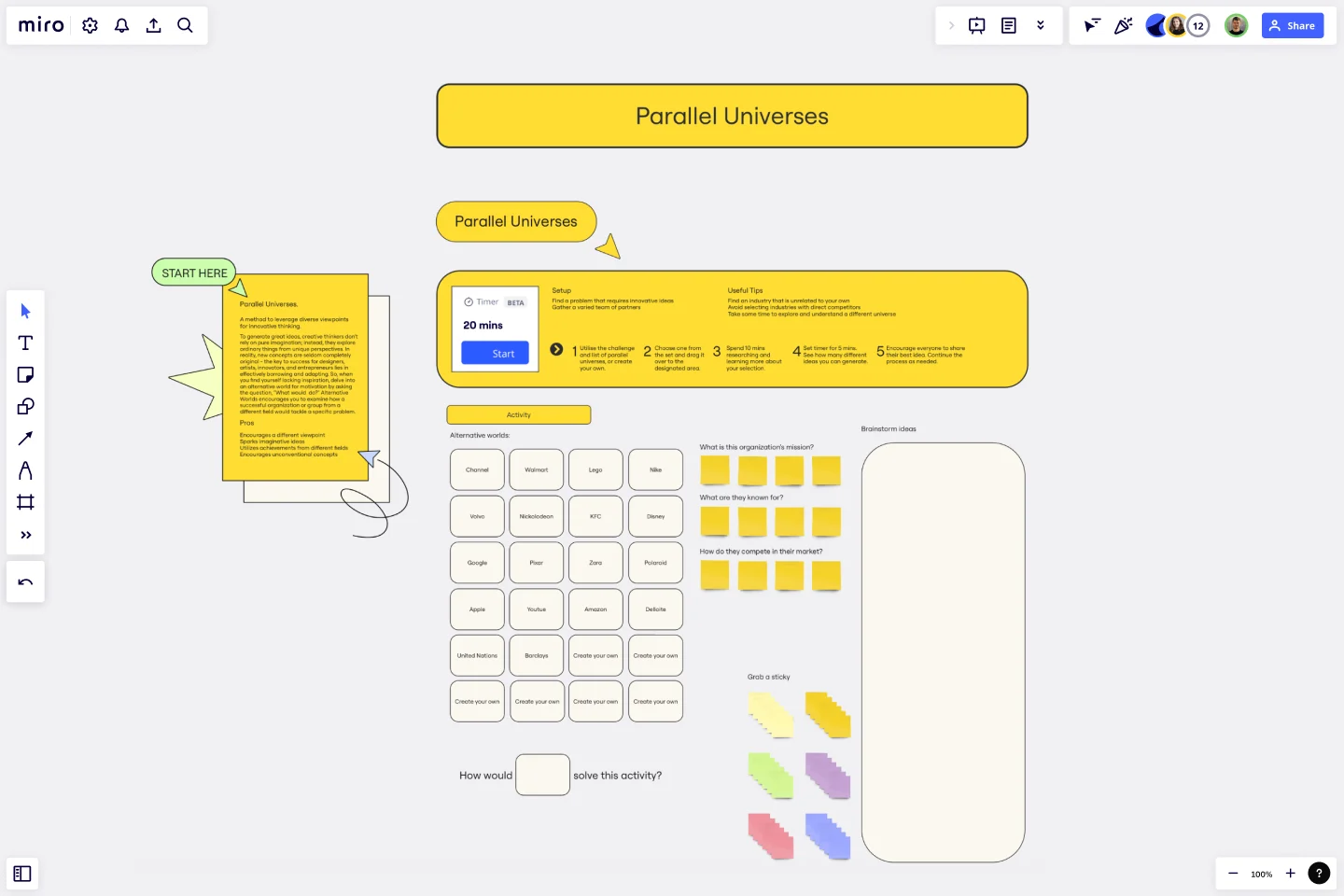Parallel Universes Template
Leverage diverse viewpoints for innovative thinking with the Parallel Universes Template.
About the Parallel Universes Template
Great ideas are not always born out of pure imagination. Creative thinkers often explore ordinary things from unique perspectives to generate innovative concepts. In reality, new ideas are seldom entirely original. The key to success for designers, artists, innovators, and entrepreneurs is effectively borrowing and adapting. Enter: Parallel Universes Template.
When you find yourself lacking inspiration, try delving into an alternative world for motivation. Ask yourself the question, "What would they do?" The Parallel Universes Template encourages you to examine how a successful organization or group from a different field would tackle a specific problem.
Benefits of using the template
Encourage a different viewpoint.
Spark imaginative ideas.
Use achievements from different fields.
Encourage unconventional concepts.
How to use the template in Miro
Use the challenge and list of parallel universes, or create your own.
Choose one from the set and drag it over to the designated area.
Spend 10 mins researching and learning more about your selection.
Set a timer for 5 mins. See how many different ideas you can generate.
Encourage everyone to share their best idea. Continue the process as needed.
Setup
Find a problem that requires innovative ideas.
Gather a varied team of partners.
Useful tips
Find an industry that is unrelated to your own.
Avoid selecting industries with direct competitors.
Take some time to explore and understand a different universe.
Get started with this template right now.
Service Blueprint by Apto Digital Innovation
Works best for:
Research & Design
The Service Blueprint template helps visualize every aspect of your service, from customer interactions to behind-the-scenes processes. Use it to align teams, improve service delivery, and ensure a seamless customer experience. This template aids in identifying pain points and opportunities for enhancement, making it an essential tool for service design and optimization. It's ideal for fostering collaboration and strategic planning.
BPM
Works best for:
Diagramming
The BPM (Business Process Management) template is a visual tool for modeling, analyzing, and optimizing business processes. It provides a structured framework for documenting process flows, identifying bottlenecks, and improving efficiency. This template enables organizations to streamline operations, enhance productivity, and drive business performance. By promoting process transparency and agility, the BPM template empowers teams to achieve operational excellence and deliver value to stakeholders.
Newsletter Template
Works best for:
Design, Marketing, Desk Research
Using a newsletter template allows you to create a structured and eye-catching newsletter for your subscribers. Add images, text, a call-to-action, and anything else that’ll keep your audience engaged. Take a look at Miro’s newsletter template to start creating unique and distinctive emails today.
Service Experience Observation Sheet
Works best for:
Research & Design
The Expanded Service Blueprint provides a detailed view of your service processes and interactions. This template is ideal for comprehensive service analysis and improvement. Use it to align teams, visualize the customer journey, and identify opportunities for optimization. It's perfect for enhancing service delivery, fostering collaboration, and ensuring a seamless and efficient service experience for your customers.
Agile Kata Storyboard
Works best for:
Storyboard, Design, Planning
Optimize your Agile processes with the Agile Kata Storyboard template. This template is ideal for Agile teams looking to improve their workflows and problem-solving techniques. It helps you visualize the steps of the Agile Kata, including problem identification, solution brainstorming, and iterative testing. Use this template to facilitate continuous improvement, enhance team collaboration, and ensure your Agile practices are effective and efficient.
Empathy Map [Research]
Works best for:
Market Research, Research & Design
Empathy Map Research template helps you gather in-depth user insights. It’s designed for teams who want to understand user behaviors and needs better. Use this template to inform your design decisions and create user-centered products.
